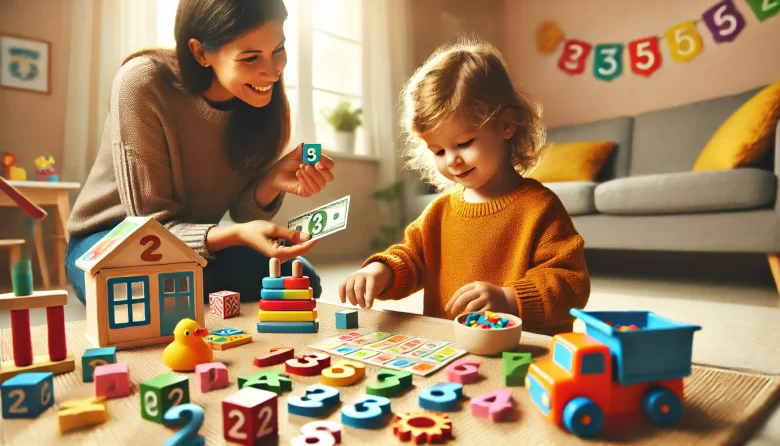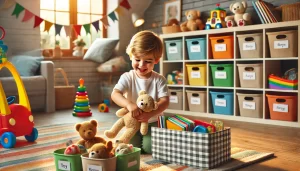Teaching young children numbers and basic math doesn’t have to feel like schoolwork. In fact, some of the best learning happens during everyday activities! By incorporating math into daily routines, children naturally develop number sense, problem-solving skills, and confidence with numbers.
Here are fun and simple ways to teach numbers and basic math at home through play and daily activities.
Counting Everyday Objects
Best for: Number recognition and counting skills
How to Play:
- Count toys while cleaning up (“Let’s put away 5 blocks—1, 2, 3, 4, 5!”).
- Count steps while walking up the stairs.
- Count pieces of fruit while making a snack.
Repetition is key! Counting everyday objects strengthens number recognition, enhances problem-solving, and helps children connect math concepts to real-life situations effortlessly.
Sorting and Grouping by Size, Shape, or Color
Best for: Logical thinking and early math concepts
Materials Needed:
- Small objects like buttons, toys, or blocks
- Bowls or baskets
How to Play:
- Ask your child to sort objects by color, shape, or size.
- Compare the groups: “Which has more? Which has fewer?”
- Encourage counting how many items are in each group.
Sorting strengthens critical thinking by encouraging kids to recognize patterns, categorize objects, and develop essential early math classification skills in a fun and interactive way!
Cooking and Baking with Math
Best for: Measuring, fractions, and following steps
How to Play:
- Let your child measure ingredients using measuring cups and spoons.
- Talk about fractions when dividing food (half an apple, quarter of a sandwich).
- Set a timer and count how long it takes to cook something.
Cooking turns math into a hands-on adventure, making learning fun while teaching essential skills like measuring, counting, and following sequences in a practical and engaging way!
Number Hunt Around the House
Best for: Recognizing numbers in daily life
How to Play:
- Find numbers on clocks, calendars, phone screens, and books.
- Play “Find the Number” by calling out a number and having your child look for it.
- Point out numbers on price tags, food packages, and street signs when outside.
This exciting game helps kids recognize numbers as an essential part of their everyday world, reinforcing number recognition, improving pattern awareness, and making learning both meaningful and fun!
Playing Store with Play Money
Best for: Counting and simple addition/subtraction
Materials Needed:
- Play money (or real coins)
- Small items to “buy”
How to Play:
- Set up a mini store with small items.
- Give your child pretend money and ask them to “buy” something.
- Help them count how much they need and how much change they get.
This engaging role-play activity sparks financial awareness while strengthening basic math skills, helping children grasp the value of money, practice problem-solving, and develop real-world decision-making in a fun and interactive way!
Singing Counting Songs
Best for: Memorization and number sequencing
Examples:
- One, Two, Buckle My Shoe
- Five Little Monkeys
- Ten in the Bed
Music transforms learning numbers into an engaging and enjoyable experience, making it easier for children to recognize patterns, improve memory, and develop a strong mathematical foundation in a playful and rhythmic way!
Using Blocks or Legos for Math Play
Best for: Counting, patterns, and problem-solving
How to Play:
- Count blocks as you stack them.
- Compare towers: “Which one is taller? Which one is shorter?”
- Make patterns using different colors or sizes.
Building play encourages hands-on learning by introducing early concepts of measurement and sequencing, helping children develop spatial awareness, problem-solving skills, and logical thinking in a fun and interactive way.
Matching Numbers to Quantities
Best for: Connecting numbers to real objects
Materials Needed:
- Number flashcards or written numbers
- Small objects like buttons or beads
How to Play:
- Write numbers on cards.
- Ask your child to place the correct number of objects next to each card.
- Count together to reinforce the concept.
This engaging activity helps children seamlessly transition from simply recognizing numbers to truly understanding their value, fostering a strong foundation for mathematical thinking and problem-solving.
Outdoor Math Games
Best for: Active learning and number practice
How to Play:
- Draw numbers with chalk and have your child jump to the correct one when called.
- Collect and count rocks, leaves, or flowers during a walk.
- Race to a certain number of steps: “Take 10 big jumps!”
Outdoor play keeps kids active and engaged while naturally reinforcing essential math skills like counting, measuring, spatial awareness, and problem-solving, all in a fun and dynamic environment.
Telling Time on a Clock
Best for: Number recognition and learning about time
How to Play:
- Show your child a clock and talk about what the numbers mean.
- Ask them to point to different numbers.
- Set a simple schedule: “Snack time is when the big hand reaches 12!”
Learning to tell time not only strengthens numerical skills but also enhances problem-solving abilities, time management, and a deeper understanding of how numbers play a crucial role in daily routines.
Final Thoughts
Teaching numbers and math doesn’t have to be boring or difficult! By making math a natural part of playtime and daily routines, children develop confidence and skills in a fun, stress-free way.
Try these activities and watch your child’s love for numbers grow! 🔢😊




